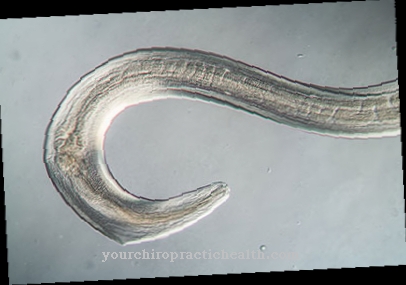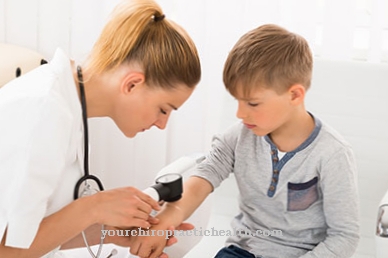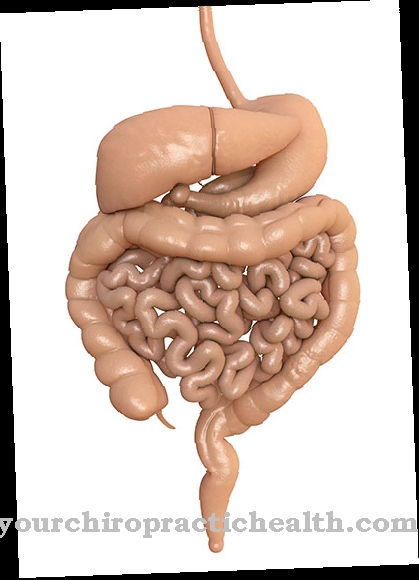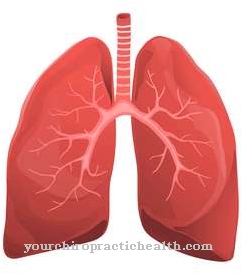The term allergic conjunctivitis describes the inflammation of the conjunctiva of the eye. The conjunctiva (conjunctiva) is the mucous membrane that rests on the eyeball.
What is allergic conjunctivitis?

The allergic conjunctivitis is common. It is estimated that around 20 percent of the population is affected.
Itching, red eyes, discharge from the nose, and the urge to sneeze are some of the symptoms that plague sufferers of allergic conjunctivitis. The most common trigger is a pollen allergy. In the treatment, antiallergic eye drops are mostly used.
causes
Many substances can irritate the conjunctiva. These include cosmetics, pet hair (cat allergy) and medication.
Eye drops or ointments and the preservative solutions for contact lenses should also be considered as causes. Most often, however, conjunctivitis shows itself as a result of an allergy to pollen. Seasonal allergic conjunctivitis and allergic rhinoconjunctivitis are also used here, as the symptoms appear depending on the season.
Usually the nose is also affected. If the symptoms persist all year round, regardless of the season, one speaks of perennial, i.e. year-round allergic conjunctivitis.
The following processes lead to inflammation at the cellular level: The allergen is dissolved in the tear film and migrates through the layers of the mucous membrane. When it hits an inflammatory cell, it releases histamine. This is a messenger substance that leads to further inflammatory cells being attracted. The inflammation is reflected in the eye as redness, water retention and itching.
Symptoms, ailments & signs
Allergic conjunctivitis manifests itself through typical symptoms such as itching and burning, red eyes and sticky eyes due to escaping secretion. The reddened eyes are the clearest sign of the disease and usually appear on both sides. With pronounced conjunctivitis, the lids and parts of the face can also be reddened, depending on the allergen.
In addition to these complaints, there is usually a feeling of pressure in the eye, which increases when touched. The flow of tears is increased and there is increased swelling in the area of the conjunctiva. Affected people are shy of light and the eyes are sensitive to stimuli such as cold or heat. Typical allergy symptoms such as sneezing and runny nose can also occur.The airways can also be affected: breathing difficulties, coughing and sputum result.
The symptoms mentioned can be limited to one eye or occur on both sides. Occasionally, the inflammation occurs on one side only and then spreads to the other eye. The intensity of the symptoms mentioned depends on the extent of the conjunctivitis. The cause of allergic conjunctivitis also determines which symptoms occur and how serious they are.
Diagnosis & course
The diagnosis of allergic conjunctivitis can primarily be made on the basis of clinical symptoms. Other forms of conjunctivitis, dry eyes and eyelid inflammation must be excluded.
The most common symptom of allergic conjunctivitis is itching and a condition called chemosis. This is a massive swelling of the conjunctiva as a result of fluid retention. The fluid arises because the vessels of the conjunctiva become more permeable due to the inflammatory processes. The eye then looks glassy and can conspicuously protrude from the eye socket.
Those affected also suffer from watery eyes and sneezing. In so-called spring catarrh, which often occurs in young men, growths can form on the inside of the eyelid. Deposits on the conjunctiva can also occur.
Complications
Allergic conjunctivitis occurs as part of an allergic reaction. One possible consequence is what is known as superinfection. Due to the allergy, the immune system in the eye is weakened and pathogens can penetrate more easily and also infect the eye. This makes treatment much more difficult.
In the course of the eye inflammation, in the worst case scenario, the cornea can become cloudy, resulting in severe visual impairment. In the rarest of cases, the affected person becomes blind. The inflammation can also lead to the formation of scar tissue on the eye, which also causes the cornea to become cloudy.
However, the scar tissue can also block the tear ducts and thus prevent the eye from moistening, which then dries out. In addition, an allergic reaction also leads to swelling of the airways. This typically leads to severe shortness of breath and difficulty swallowing for the person concerned.
Quincke's edema is also conceivable, in which case fluid collects in the deep layers of the skin, leading to even greater swelling. The worst case of an allergic reaction is anaphylactic shock, in which there is a sharp drop in blood pressure. This can be a life-threatening condition, as as a result important organs are no longer supplied with enough blood and can therefore fail.
When should you go to the doctor?
The tearing, itching, and burning sensation associated with allergic conjunctivitis can sometimes be effectively relieved with cool compresses or artificial tears. These are available in any drugstore without a prescription and can be stored in a cool place for a long time.
In this case there is no need to see a doctor. Stubborn complaints sometimes hide a more serious eye disease, which announces itself at the beginning with symptoms similar to the "red eye". An ophthalmological examination is inevitable after six hours of constant complaints at the latest.
Allergic conjunctivitis is very uncomfortable, especially for younger children. Since these are difficult to keep from rubbing the eyes, there is a risk that bacteria will penetrate or the conjunctiva will swell painfully. Children affected by allergic conjunctivitis should therefore always see an ophthalmologist.
If patients of any age regularly suffer from conjunctivitis, an allergy test is recommended. It is offered equally by ear, nose and throat specialists, dermatologists (dermatologists) and general practitioners. However, further training in allergology is essential for a precise diagnosis.
Doctors & therapists in your area
Treatment & Therapy
The primary treatment goal for conjunctivitis is to desensitize the conjunctiva. This can be achieved with astringent eye drops. They change the protein components of the conjunctiva.
The use of antihistamines is also possible. They inhibit inflammatory cells from secreting histamine, which causes the symptoms. Antihistamines are available from pharmacies as part of tablets, juice or eye drops.
Eye drops have the decisive advantage over the other preparations that they act directly on the inflammation process and the effect occurs after a few minutes and usually lasts for up to 12 hours. They are also commercially available as single doses and then usually do not contain any preservatives.
Antiallergic eye drops should be used without contact lenses, otherwise the conjunctiva can be further irritated. Unless otherwise prescribed, antiallergic eye drops are put on the eyes two to four times a day.
One drop is placed in each eye. The duration of treatment with antiallergic eye drops should be limited to two weeks for self-medication. If the doctor prescribes it, it can be used for months. Redness and burning sensation can occur as side effects. In case of hypersensitivity, antiallergic eye drops are contraindicated.
Another possible group of drugs are mast cell stabilizers. These are preparations that directly prevent the mast cells (inflammatory cells) from secreting histamine. Mast cell stabilizers can be administered as eye drops or orally.
Short-term cortisone can also bring relief in the case of greater stress. However, preparations containing cortisone should be used very carefully. With prolonged use, they can lead to cataracts (clouding of the lens) and glaucoma (increase in intraocular pressure).
Occasionally, conjunctivitis is due to poor hygiene. Then it is the bacterial toxins that cause the inflammation. Antibiotic use should be considered in this type of conjunctivitis.
Outlook & forecast
With this disease, there are mainly severe discomfort to the eyes. Those affected mainly suffer from itchy and red eyes. However, scratching and rubbing the eyes usually only exacerbates the itching. Without treatment, conjunctivitis can also occur. The patients suffer from severe pain directly in the eyes. The eyes themselves can water and are in many cases sensitive to light.
If there is no treatment, this complaint can also lead to loss of vision or visual problems. It is also not uncommon for people to sneeze heavily. The eye itself usually protrudes from the eye socket and can look unusual. This complaint can lead to bullying or teasing, especially in children. All of these symptoms reduce the patient's quality of life.
In most cases, the disease can be treated with medication. Eye drops are also used. The life expectancy of the patient is not restricted. In some cases, a cataract or glaucoma can occur even after the treatment.
prevention
As a preventive measure, people who frequently suffer from conjunctivitis should use allergy-tested cosmetics and not touch their eyes. Hands should be washed regularly to prevent bacterial infection.
Aftercare
Allergic conjunctivitis can flare up again and again if an allergen cannot be consistently avoided. Follow-up care therefore not only relates to the symptoms that have occurred with this form of conjunctivitis. It also relates to measures with which an allergen can be avoided in the best possible way.
In addition, follow-up care by an ophthalmologist is recommended after severe cases of allergic conjunctivitis. He will also provide information about individual aftercare measures. The family doctor and contact person are also professional contacts. Red and dry eyes are hallmarks of the irritative state of allergic conjunctivitis. The sensitive conjunctiva of the eye must therefore be protected from further irritation during aftercare.
This applies to sharp cleansing products on the face as well as to make-up such as kohl, mascara and eye shadow or drops of sweat that can trickle into the eyes during exercise. Moisture drops for the eyes can be used in consultation with the ophthalmologist in order to moisten the eyes in a targeted manner and to consistently prevent further irritation.
Allergic conjunctivitis follow-up care for pollen avoidance includes washing your hair before bed during the pollen season, using pollen filters in the car, and cooling your eyes rather than rubbing them with your fingers if it itches and causing irritation. Walks with pollen count are usually less allergenic in the evenings.
You can do that yourself
Allergic conjunctivitis is conjunctivitis of the eyes, which usually has a good prognosis and in which those affected can do a lot in everyday life to prevent or alleviate the classic symptoms.
One of the prerequisites for this is the willingness of the patient to avoid the triggering allergen as far as possible. This applies to the pollen filter in the car and the nightly washing of hair in the case of pollen allergies, as well as to the renouncement of cosmetics, in which the person concerned is allergic to certain ingredients. All of this can serve to limit the extent of allergic conjunctivitis somewhat in advance.
When conjunctivitis breaks out, there are also some ways in which the person affected can contribute to rapid healing. In this context, it is particularly important that the patient controls himself despite the sometimes severe itching and does not constantly rub his eyes with his fists.
Help is provided by wetting the irritated area around the eyes with cold water or applying a cool compress. In consultation with the attending physician or ophthalmologist, special solutions can also be used to provide the eyes with moisture. They are ideal against the dryness of irritated eyes and in many cases also take away the feeling of having a grain of sand in your eyes.



























